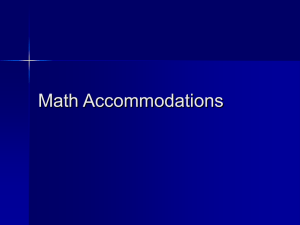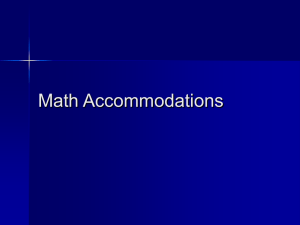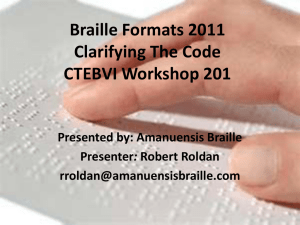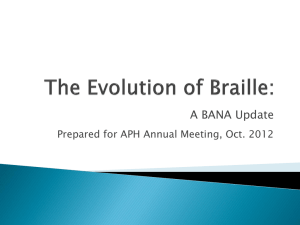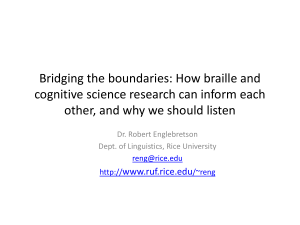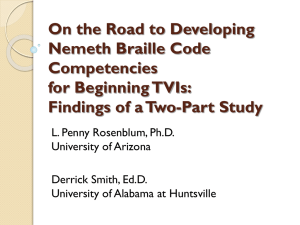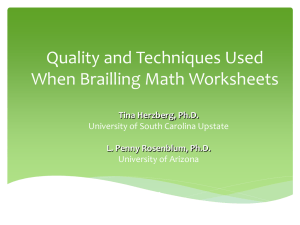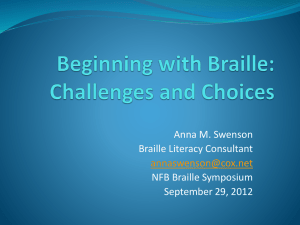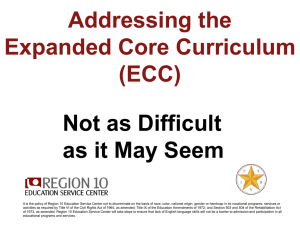Refresh Your Nemeth Code
advertisement
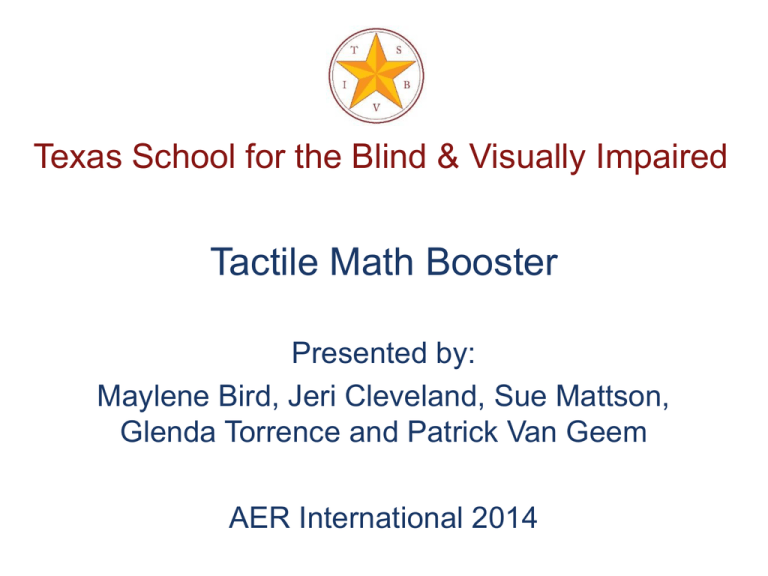
Texas School for the Blind & Visually Impaired
Tactile Math Booster
Presented by:
Maylene Bird, Jeri Cleveland, Sue Mattson,
Glenda Torrence and Patrick Van Geem
AER International 2014
Texas School for the Blind
&
Visually Impaired
Refresh Your Nemeth Braille Code
Maylene Bird, TVI and COMs
Glenda Torrence, TVI
Why did we do this?
• Why?
Braille Examples:
2+3 = ch
2+3 = 5
2 + 3 = ch
2+ 3= 5
Mistakes by students, mistakes found in textbooks, commonly found errors or ones we always have to look up. It is important to
preserve our Nemeth Code. It is important for our students to learn math. Math has it's own special set of symbols and can not be
treated as a literary code.
Common Errors and Forgotten
Signs
• Top 3 errors noted by TVIs.
• Symbols we often forget.
• Miscellaneous items.
Picture of woman pondering: "Where is the guzinto sign?"
Long Division
• 4284 divided by 6 equals 714.
Notes: In print this symbol is the vinculum; correctly read as: 4284 divided by 6.
Top 3 List
• Spacing: To space or not to space
• Dot 5
• Numeric indicator
We will start with a list of frequently seen Nemeth Code errors.
To Space Or Not To Space
2. (5, 6)
Space before and after signs of
comparison
3. 2+9 = 11
4. 3<7
5. 5>1
We know the equal and > and < are signs of comparison. Space before and after..
Remembering > and <
• How to remember < and > symbols on the
Braille writer. (Print students have the
alligator)
• Greater than:
– Right hand dots: 4, 6
– Left hand dot: 2
• Less than:
– Right hand dot: 5
– Left hand dots: 1, 3
Alligator for Print
6. x is not equal to 4
7. y is less than or equal to15
8. r is greater than or equal to 25
Signs of Comparison Continued
A chart comparing popular male cartoon figures in the following categories: White shirt, Blue pants, Seth McFarlane, Good show.
To space or not to space:
Signs of Comparison continued
Note: Notice space before and after these signs of comparison congruent, approximately equal to, parallel and perpendicular.
To space or not to space: Signs of
Comparison (Continued)
13. The ratio x to y.
14. x ꞉ y
15. 1 ꞉ 2 ꞉꞉ 2 ꞉ 4
The word 'to' is spelled out, uncontracted, and not hooked to the variable 'y'. Problem 15 reads one is to 2 as 2 is to 4.
Spacing Continued
16. A is a subset of B.
17. x is an element of Real numbers.
18. {x | 3 ≤ x < 10}
19. The symbol for “therefore”
An example for 19 is: All men are mortal, Socrates is a man, therefore Socrates is mortal.
Intersection and Union Symbols
20. Find A∩B
Braces and Brackets
• Parenthesis (7)
• Braces {7}
• Brackets [7]
There is no particular significance in the use of square brackets instead of parentheses. Brackets and curly-braces are used when
there are nested parentheses, as an aid to keeping track of which parentheses go with which. When working with nested
parenthesis, the order will always be: parenthesis, brackets, and braces as shown: {[( )]}.
Braces and Brackets
21. {x | -5 ≤ x < 5}
22. [-5, 5)
Number 21 is set builder notation. Another way to represent 21 is shown in 22. The is interval Notation using bracket and
parenthesis. It is also represented by the number line on the next slide.
Graphing Set Notation
Students can graph over the tic marks, but the correct way is to leave them uncovered. Caution students to at least leave the first
tic mark at -5 uncovered. The full cell above the number line signifies shaded/filled in circle. Notice there are no number signs
used on the line graph.
Braces and Brackets
23. [5-(3+4)] = ?
24. {-2, 0, 2}
Number 23 is just PEMDAS (Please excuse my dear aunt Sally
Number 24 is another set; finite set with 3 elements.
Dot 5
• Normal level of writing is on the baseline. Subscripts
are below the baseline and exponents are elevated.
The term superscript is used to define any letter,
sign, or symbol written above the baseline.
Exponents/Superscripts
(dots 4, 5)
25. 90⁰+90⁰ = 180⁰
26. x²+6x+3²
27. x²+1
28.
29.
1
𝑥2
=5
This should
read: 1 over x squared equals five
Use dot 5 when ti is followed by another symbl. Do not use if it is followed by a space.
Subscripts
(dots 5,6)
29. H2O
30. 2H3PO4 → H4P2O7 + H2O↑
31. (x1, y1)
Number 30 reads: 2H3PO4 yields H4P2O4 plus H2O gas
Don't use a dot 5 if a subscript indicator is not used. {X followed by a subscript a is when you do use a subscript indicator}. When
you have an x subscripted by a letter then use subscript indicator.
Reference
• The Braille Code for Chemical Notation 1997
available through the American Print House
for the Blind
Exceptions to the
Dot 5 Rule
32. x2 , x3
33. x12 + 9
34. x12+9
Slope
• No dot 5 is used here for the slope equation.
• Rule: if a letter is followed by a numeric
subscript then do not use dot 5.
Dot 5 continued…
• Dot 5 at the beginning or with a space in front of it
indicates something immediately following will be
modified.
The Numeric Indicator
The last of the big three.
Non use of the Numeric
Indicator
• Computation problem written in spatial
arrangement do not use a number sign.
• Problems written horizontally start with a
number indicator unless preceded by …
Non-use of Number Indicator
• Don't use the number indicator when a
number follows the opening parenthesis
Non-use of Number Indicator
• No Number Indicator in front of an Opening
Fraction indicator
Use of Number Indicator
46. The distance from the Earth to the Sun is
about 92,955,807.
47. (1, 2, 3, 4, 5, 6, 7, 8,
9, 10, 11)
If a long number cannot fit on 1 line, begin the number on a new line or even a new page. There is a way to split a number, but it
is highly discouraged. A hyphen (3, 6) is inserted after a comma and a new numeric indicator is placed at the beginning of a new
line. On problem 47 the numeric indicator is not required before the 9.
Miscellaneous
The next items are to refresh your memory about other areas of mathematics and the Nemeth symbols. The photo shows 5 staff
members of TSBVI dressed as beauty queen contestants. The constants represented: Mis-behave, Mis-understood, Mis-fit, Misapprehension, Mis-cellaneous, and Mis-do.
Infinity and Beyond
48. No special spacing required--it follows rules in the context in which it is used. 6,250
49. The infinity symbol is a full braille cell, dots 1, 2, 3, 4, 5, 6.
Repeating Decimals
• Notice how a repeating decimal is written in
Nemeth.
50. Use dots (1, 5, 6) when only 1 number is repeating. 51. If more than 1 digit repeats, you must note where the repeating
sequence starts with a dot 5 and use the over the top symbol and bar symbol. It ends with a termination symbol.
Tally Marks
52. A tally mark in Nemeth is dots 4, 5, 6. They
are grouped 5 in a row with a space between
groups of 5.
Absolute Value
Square Roots and Radicals
Problem 55 depends on the math level; if you ask for 2 square roots (plus or minus). 56. The index of the cube root is written first
and then the radical (root) sign and the number under the radical (in this case the 8 which is called the radicand). Remember to
terminate the radical sign after both!
Mixed Numbers and Complex
Fractions
In problem 57 do not forget the (4, 5, 6) before closing the fraction! Note the opening fraction indicator in number 58.
Line Graphs
59. Notice that the tic marks are not covered by the graphing {dots (2, 3, 5, 6)}. The X dots (1, ,3, 4, 6) above the line graph
signifies the unshaded circle. Remember you do not need number to labels the numbers on number line.
Dedication
• Dedicated to Dr. Abraham Nemeth
– October 16, 1918 to October 2, 2013.
References
AAWB-AEVH-NBA Advisory Council to the Braille Authority (1979). The
nemeth braille code for mathematics and science notation, 1972 revision.
Louisville, KY: American Printing House for the Blind.
Braille Authority of North America, (1997). Braille code for chemical notation
1997. Louisville, KY: American Printing House for the Blind.
Craig, R.H. (1987). Learning the nemeth braille code; A manual for teachers
and students. Louisville, KY: American Printing House for the Blind.
Laudenslader, E., (1972). Braille handbook for nemeth code of braille
mathematics and scientific notation. San Francisco State College.
Roberts, H., Krebs, B.M., & Taffet, B., (1978). An introduction to braille
mathematics. Washington, DC: Library of Congress.
Emails and Other links
•
•
•
•
•
Maylene Bird (birdm@tsbvi.edu)
Glenda Torrence (torrenceg@tsbvi.edu)
Susan's Math Page (http://www.tsbvi.edu)
Abacus Videos (http://www.tsbvi.edu.com/user/VideoTSBVI)
National Braille Association
(http://www.nationalbraille.org/NBAResource/FAQs/(askanexpert)
• Braille Authority of North America
(http://www.brailleauthority.org/)
Texas School for the Blind
&
Visually Impaired
Braille Production
Sue Mattson, Braille Transcriber/
Adapted Materials Specialist
Theme
• "Do not let what you cannot do
interfere with what you can do!"
--John Wooden
Unraveling the Problems
•
Nemeth Braille Code
• Reference materials
•
Software issues
• Compatibility problems
•
Math issues
• Uncomfortable with math
The Nemeth Braille Code
•
It isn't rocket science
• 63 palpable braille characters (64
including the space)
• It evolved out of rules of speech
Software Issues
•
Understanding the multiple layers of software
use
•
Knowing what programs to use and how they
work together
•
Windows updates and the impact on your
work
Related Problems
•
File formats and how to handle them
• PDFs, Word files …
•
Type of documents
• Electronic copies, hard copies
MS Word and Math Type
•
Using Math Type with MS Word
• An equation editor
• Installs a tab on the Word Ribbon
• Keyboard short cuts are easily
customizable
• Commonly used in schools
• Not expensive
MathType Equation Editor
Define Sizes
Define Styles
Set Preferences
Duxbury
•
Create document in MS Word using the
BANA Braille 2014 template or
•
On an existing document apply the BANA
Braille 2014 template
•
Format using the style pane
•
Save and open in Duxbury
BANA Braille 2014 Template
Math Issues
•
Build a support system
•
Teachers
• Transcribers
• Online resources
Other Problems
•
Lead Time
• How much time do you have from
receiving assignment until it is needed
by student?
• Difficult to overcome misinformation
•
Communicate with teachers
Hardware
•
Graphic Embossers
•
Tigers
• Phoenix
Conclusion
•
"We cannot hope that many children will
learn mathematics unless we find a way
to share our enjoyment and show them its
beauty as well as its utility."
--Mary Beth Ruskai, University of Waterloo
Ontario, Canada
Texas School for the Blind
&
Visually Impaired
Supporting Tactile Learners
Jeri Cleveland, TVI
(Curriculum Teacher, TSBVI)
Tactile Learners
•
Your tactile learners do not have to be
Do Your Students Feel
Like:
•
Villain: "You must read the graphic!
•
Heroine: "I can't read the graphic!"
Tips for Supporting Tactile
Learners in Mathematics
•
Excellent posture
•
Systematic exploration
•
3-D to 2-D (Flat Stanley)
•
Text before graphics
•
Familiar Features
Tips (continued)
•
Perspective and dimensionality
•
Shared language
References
•
Lost in Space poster, Retrieved online
from http://www.imdb.com/title/tt0058824/
•
Villain and heroine photo, Retrieved
online from
http://www.carolynscottphotography.com/2
012/02/29/love-derailed-lindseymarksdamsel-in-distress-engagement-sessionfeaturing-brent-the-villain/
Tactile Graphic Document Production
for
School-based Mathematics Worksheets
Texas School for the
Blind and Visually
Impaired
Texas School for the Blind and Visually Impaired
Austin, Texas 78756
Outreach Programs
TSBVI
Criteria for Including a Tactile Graphic
•
•
•
•
•
Introduce at an early age.
All required information included.
Omitting vs Admitting diagrams.
Complex Diagrams (meaningful?)
Include if it is used to answer questions.
TSBVI
Planning and Editing
•
•
•
•
•
•
More meaningful in text form?
What is information is conveyed?
Planning Components
Editing Content
What production method is used?
Planning Process Sheet
TSBVI
Object Components
•
•
•
•
Area (no less then .25” width/height)
Line (1,3, and 6 point)
Points (no less than .13” diameter)
Label (only horizontal labeling)
TSBVI
What is order of these elements?
21
12
4
5
35
34
TSBVI
Order of
Elements in a
Tactile Graphic
• Heading, Titles, and Numbered
Figures
• Illustration Captions
• Questions and Answer Choices
• Transcriber’s Notes
• Keys Content and Format Order
1.
2.
3.
4.
Area
Lines
Points
Letters
• Placement of Tactile Graphics
• Label Placement
Content Information
TSBVI
Title
(5-5)
Caption
(3-1)
Question
(1-5)
Answer Choices
(3-5)
TSBVI
Transcriber’s Notes
Title
Transcriber’s Note
Symbol (begin 7-5)
Key:
(7)
Area Keys
(.50” wide)
Letter Keys
Transcriber’s Note
Symbol (end)
TSBVI
Tactile Graphic Illustration
Title
Y-axis Content
Axis Line
(3-4.5 pts)
Numbering
Coordinate Line
(1 pt)
Objects
(.25” width)
X-axis Content
TSBVI
Readability
• Text Content
– Follow the BANA Braille Formatting Standards
• Transcriber’s Notes
– Short and at students grade level.
• Tactile Graphics
– Follow the BANA Tactile Graphics Guidelines
TSBVI
CCS
• Consistency
• Continuity
• Standardization
Thank you!
Tactile Math Booster
A Production of TSBVI, 2014
